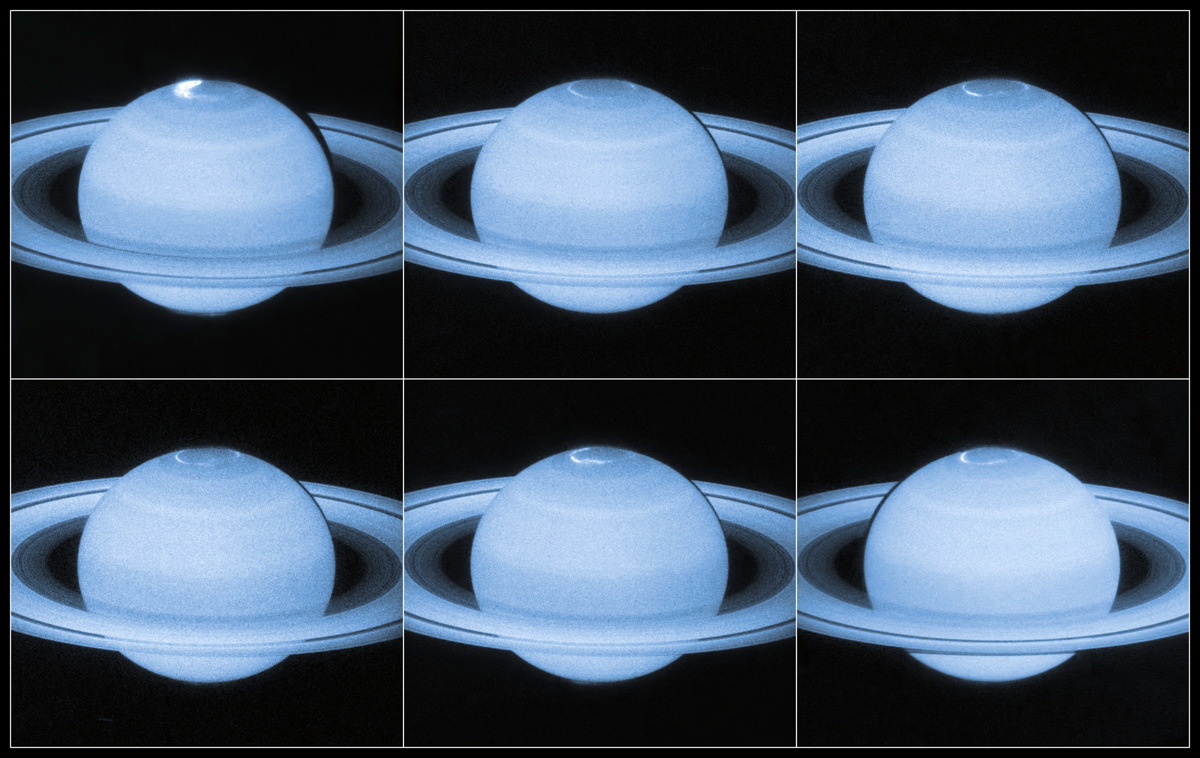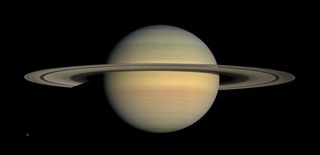Saturn's Amazing Northern Lights Dance in Hubble Telescope Photos

Saturn's northern lights dance in ethereal blue light in a series of amazing images captured by the Hubble Space Telescope.
Bright flashes of auroras glow against the blue backdrop of Saturn's north pole in the new ultraviolet images released by the European Space Agency on May 19. The newly released images show bits of time when streams of particles shot out by the sun affected Saturn's magnetic field, ESA officials said in a statement.
"Saturn was caught during a very dynamic light show," ESA officials said. "Some of the bursts of light seen shooting around Saturn’s polar regions travelled more than three times faster than the speed of the gas giant’s roughly 10-hour rotation period!" [See more amazing photos taken by the Hubble Space Telescope]
Hubble captured the pictures in April and May of 2013, and they may help scientists learn more about how the planet's auroras change. The photos reveal previously unnoticed details about the choreography of the northern light, ESA officials added.
"Saturn has a long, comet-like magnetic tail known as a magnetotail — as do Mercury, Jupiter, Uranus, Neptune and Earth," NASA officials said of the observations in a statement. "This magnetotail is present around planets that have a magnetic field, caused by a rotating core of magnetic elements. It appears that when bursts of particles from the sun hit Saturn, the planet’s magnetotail collapses and later reconfigures itself, an event that is reflected in the dynamics of its aurorae [auroras]."

The Hubble photos are part of a three-year observing campaign with Hubble and Cassini. The two spacecraft have also captured a 360-degree view of Saturn's north pole and south pole auroras, NASA officials said.
Cassini has been in orbit around Saturn since 2004 and is now on an extended mission that will last until at least 2017.
Get the Space.com Newsletter
Breaking space news, the latest updates on rocket launches, skywatching events and more!
The Hubble Space Telescope — run by ESA and NASA — launched to space in 1990. Unlike Cassini, the space telescope makes its observations from an orbit near Earth. Scientists hope that Hubble will continue to make observations until about 2020.
Follow Miriam Kramer @mirikramer and Google+. Follow us @Spacedotcom, Facebook and Google+. Original article on Space.com.
Join our Space Forums to keep talking space on the latest missions, night sky and more! And if you have a news tip, correction or comment, let us know at: community@space.com.

Miriam Kramer joined Space.com as a Staff Writer in December 2012. Since then, she has floated in weightlessness on a zero-gravity flight, felt the pull of 4-Gs in a trainer aircraft and watched rockets soar into space from Florida and Virginia. She also served as Space.com's lead space entertainment reporter, and enjoys all aspects of space news, astronomy and commercial spaceflight. Miriam has also presented space stories during live interviews with Fox News and other TV and radio outlets. She originally hails from Knoxville, Tennessee where she and her family would take trips to dark spots on the outskirts of town to watch meteor showers every year. She loves to travel and one day hopes to see the northern lights in person. Miriam is currently a space reporter with Axios, writing the Axios Space newsletter. You can follow Miriam on Twitter.